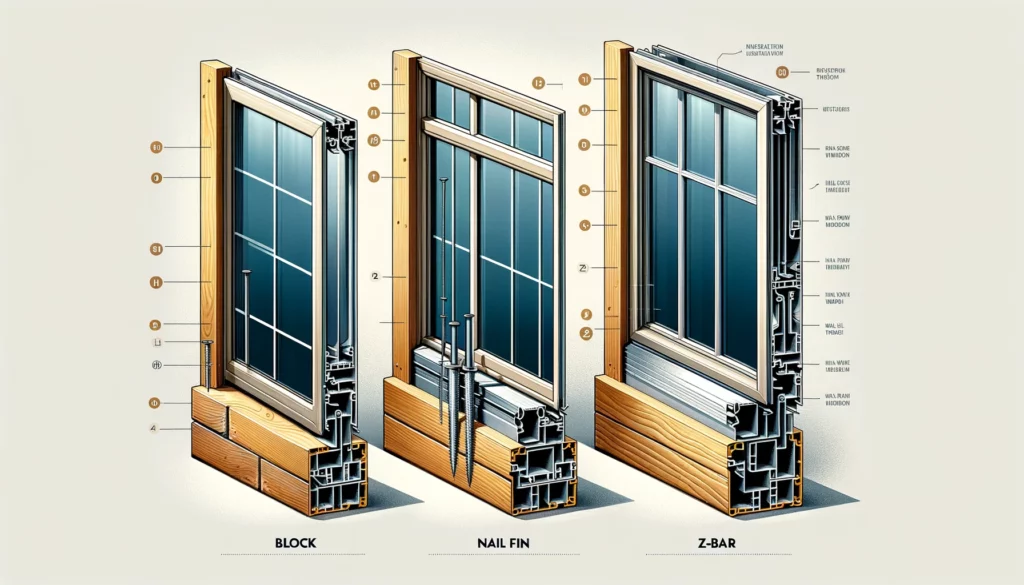Understanding Milgard Windows: Block vs Nail Fin vs Z-Bar
When it comes to window installation, understanding the differences between Block, Nail Fin, and Z-Bar for Milgard windows is crucial. These technical terms play a significant role in ensuring your windows are installed correctly and function efficiently. As a homeowner or contractor, choosing the right window frame type can impact not only the installation process but also the overall performance and aesthetics of your home. The proper installation of Milgard windows, whether using a block frame, nail fin, or Z-bar, ensures that your window and window frame options align perfectly for optimal durability and visual appeal. Define your needs when choosing the right Milgard window.
Replacement Windows and Window Frame Types
When considering replacement windows, it’s essential to understand the various frame types available. Milgard Windows offers different options to accommodate multiple installation methods and preferences. The primary window frame types are Block, Nail Fin, and Z-Bar. Each of these has unique features and benefits for different scenarios.
- Block Frame: Block frame windows fit snugly into existing frames, which is ideal for replacement installations when the old frame is in good shape.
- Nail Fin: Nail fin windows, with a flange that extends around the perimeter, are perfect for new constructions.
- Z-Bar: Z-Bar frames, fitting over existing frames, are commonly used in retrofit replacement windows when existing frames are compromised.
What’s the Difference Between Block, Nail Fin, and Z-Bar for New Construction?
In the realm of new construction, picking the right window frame type for your Milgard windows is crucial for a successful installation. Each frame type, whether it’s a block frame, nail fin, or Z-bar, offers distinct advantages tailored to specific scenarios. The block frame is typically used in replacement applications, while the nail fin or flange is perfect for new construction. Conversely, the Z-bar is excellent for retrofitting windows in existing homes. Let’s take a closer look at how the block frame, nail fin, and Z-bar can make a difference in new construction settings, ensuring your Milgard windows are correctly installed.

Block Frame for New Construction
While block frame windows are typically seen in replacement projects, they can also be used in new construction if the design allows. Block frame windows are ideal when the new construction involves building around existing structures or integrating the window frame into a more traditional building style. These Milgard windows provide a streamlined installation process, especially when working with wood frames or other existing materials. By opting for block frame windows, your home’s exterior can achieve a cohesive look, seamlessly blending the new windows into the design. If you’re considering block frames for your windows, it’s essential to assess how they fit with the rest of your home’s construction.
Nail Fin for New Construction
Nail-fin windows are the preferred choice for most new construction projects. Their built-in flange allows for straightforward attachment to the wall studs, ensuring a secure and weather-tight installation. The nail fin creates a continuous barrier against water infiltration, making these windows highly effective in preventing leaks and drafts. Additionally, the nail fin provides extra stability, which is crucial for maintaining the window’s integrity over time.
In new construction, the use of nail fin windows simplifies the installation process, as the windows can be installed before the exterior siding or other cladding materials are applied. This ensures a tight seal and helps maintain the structural integrity of the building envelope.
Z-Bar for New Construction
Although Z-bar windows are predominantly used in retrofit applications, they can also be employed in new construction under certain conditions. Z-bar windows are handy when dealing with irregular or non-standard openings that require additional coverage and adjustment. The Z-shaped window frame accommodates variations in the opening size, ensuring a secure fit and a polished appearance.
In new construction, Z-bar windows can provide flexibility in design and installation, especially when working with custom or unique architectural features. They are also beneficial in situations where the construction process involves integrating new windows into an existing structure with non-standard openings. This makes Milgard windows with a Z-bar option a versatile choice for new architectural projects involving stucco or other exterior finishes.
Window and Door Considerations for Home Construction
When planning for window and door installations in new home construction, several factors must be considered to ensure the best results. Here are some key points to keep in mind:
- Building Codes and Regulations: Ensure all window and door installations comply with local building codes and regulations, including requirements for energy efficiency, safety, and structural integrity.
- Climate and Weather Conditions: Select window frame types suitable for the local climate. Nail fin windows with secure, weather-tight installations are ideal for areas prone to heavy rainfall or high winds.
- Aesthetic Preferences: Consider the architectural style and design preferences of the home. The choice between block, nail fin, and Z-Bar windows impacts the overall appearance and curb appeal.
- Energy Efficiency: Opt for window frames offering excellent insulation and energy efficiency. Milgard Windows is known for high-performance materials that help reduce energy consumption and maintain comfortable indoor temperatures.
- Installation Process: Assess the ease of installation for each window frame type. Nail fin windows are often the easiest to install in new construction, while Z-Bar and block frame windows may require additional adjustments or modifications.
Choosing the Right Frame for Your Milgard Windows
When it comes to Milgard windows, choosing between block frames, nail fins, and Z-bar can significantly impact your window installation’s success and longevity. Understanding these options ensures you select the right frame for your specific needs.
- Block Frame: Perfect for replacement projects where the existing frame is in good condition, offering a clean and straightforward installation.
- Nail Fin: Ideal for new construction, providing a secure, weather-tight fit by attaching directly to wall studs.
- Z-Bar: Excels in retrofit applications, covering gaps and imperfections with their unique Z-bar.
By carefully considering your project’s requirements, you can make an informed decision that enhances your home’s aesthetics and functionality. For more information on choosing the right frame for your Milgard windows, visit our comprehensive guide.
Conclusion for Block vs Nail Fin vs Z-Bar for Milgard Windows
In conclusion, understanding the differences between Block, Nail Fin, and Z-Bar frames for Milgard windows is essential for successful window installations in both new construction and replacements. Each frame type offers unique benefits to ensure your windows work optimally. Block frame windows are ideal for replacements where the existing frame is retained, providing a clean installation. Nail fin windows are perfect for new construction, offering a secure, weather-tight fit by attaching directly to the wall studs. Z-Bar windows are best for retrofits, covering gaps and imperfections with their unique Z-shaped frame. For more detailed information and expert advice on Milgard windows and frame types, contact us at San Diego Window Replacement. We’re here to help with all your window installation needs and ensure you make the best choice for your home.
